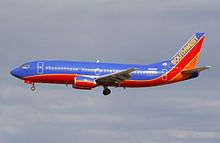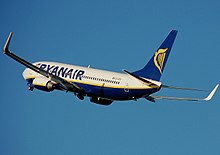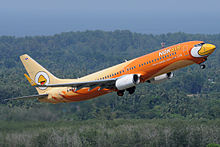low-cost airline
A low-cost airline (also known as low-cost airline , colloquially : low -cost carrier , no frills airline , budget airline ) is an airline that offers flights cheaper than classic airlines and does without comfort features. Services such as providing food and drink are usually only offered for a fee or not at all. In contrast to network carriers , who offer a dense route network with transfer options, low-cost airlines mainly work with direct connections .
emergence and development
The principle of low-cost airlines comes from the USA and was started there by Southwest Airlines in 1971. The first European airline in this category was Laker Airways , which also offered intercontinental low-cost flights, but this failed. In 1978, the Airline Deregulation Act was passed in the United States. This has encouraged low-cost airlines, as they have been able to introduce cheaper special fares, among other things, but it has also increased corporate concentration and longer-term prices.
Ryanair adopted the model in 1991 and has been expanding across Europe since 1995. In 1994, only around three million passengers flew with low-cost airlines, most of them with Ryanair, by 1999 there were already around 17.5 million. In 1995, British Airways decided to set up its own low-cost division called Go , which began operations from London Stansted Airport in 1998 . In the same year, easyJet began operations from London Luton . KLM followed British Airways' example in 2000 by launching the low-cost airline Buzz . Wizz Air started operations in 2003 with four bases. In the 2019 financial year, it transported 39.8 million passengers. In 2020, the airline operates 124 aircraft and 32 bases in Europe and is about to establish its subsidiary Wizz Air Abu Dhabi . [outdated]
In Europe, easyJet and Ryanair are among the most successful low-cost airlines, because they have been able to increase their passenger numbers enormously due to deregulation in air traffic. Since Ryanair opened a base in Frankfurt-Hahn 100 kilometers from Frankfurt am Main in February 2002, and two German low-cost airlines, Germanwings and Hapag-Lloyd Express (today TUIfly), took off from Cologne/Bonn Airport in autumn 2002 , the low - cost airlines have also been booming in Germany. On average, every fifth flight in Germany is operated by a low-cost airline. This means that the share of low-cost airlines in the number of flights in Germany has quadrupled in the last six years. Environmental organizations criticize this development.
rankings
By capacities worldwide
According to the databases of Innovata LLC, which keeps statistics on the top 800 airlines, low-cost airlines are ranked by passenger capacity in the following order:
| airline | rank | Country | capacity |
|---|---|---|---|
| Southwest Airlines | 1 |
|
3,601,236,348 |
| Ryanair | 2 |
|
2,740,188,447 |
| easyJet | 3 |
|
1.590.205.540 |
| JetBlue Airways | 4 |
|
1.264.619.457 |
| Gol Transportes Aereos | 5 |
|
959.324.747 |
| Lion Air | 6 |
|
833.940.341 |
| west jet | 7 |
|
701.488.502 |
| Norwegian Air Shuttle | 8th |
|
602.731.882 |
| Jetstar Airways | 9 |
|
592.318.049 |
| AirTran Airways | 10 |
|
590.901.890 |
After departures in Germany

In the Low Cost Monitor published twice a year by DLR and ADV , a ranking was made of the low-cost airlines operating in Germany. The table compares the departures in a week in January 2015 with a week in July 2018. Both directions of a route were taken into account for domestic German routes.
| 1/2015 | 2/2018 | |||||
|---|---|---|---|---|---|---|
| airline | Rank Germany |
Rank Europe |
market share
Germany in % |
rank
Germany |
rank
Europe |
market share
Germany in % |
| Germanwings / Eurowings | 1 | 5 | 38.3 | 1 | 3 | 48.1 |
| Ryanair | 3 | 1 | 8.2 | 2 | 1 | 18.1 |
| easyJet | 4 | 2 | 7.2 | 3 | 2 | 16.2 |
| Wizz Air | 5 | 8th | 2.2 | 4 | 6 | 4.0 |
| Laudamotion | - | - | - | 5 | 16 | 4.0 |
| Norwegian | 7 | 4 | 1.7 | 7 | 5 | - |
| Vueling | 9 | 7 | - | 8th | 4 | - |
| Air Lingus | 10 | 10 | - | 9 | 9 | - |
| AirBaltic | 11 | 13 | - | 10 | 13 | - |
Characteristics of low-cost airlines
There is no universally accepted definition of a low-cost airline. When an airline is labeled as a low-cost airline, it has certain characteristics, although not all characteristics are typically met by every airline. The airlines can offer the tickets cheaply due to the following features:
- Only one aircraft type (mostly very young fleet due to better fuel efficiency and lower maintenance costs)
- High seat occupancy (due to dynamic pricing policy )
- Selling tickets directly via your own website (bypassing GDS fees)
- Use of smaller airports to reduce take-off and landing fees
- Low turnaround time (TAT) (time at the airport between landing and takeoff again)
- A high daily usage time of the aircraft
- Use of own, often remote, terminals
- Boarding of passengers via gangways with stairs instead of passenger boarding bridges
- Crew in the legally permitted minimum strength
- Little organization of employees in unions
- High number of aircraft seats in the cabin due to only one onboard class
- Seat reservation only at extra charge
- Additional services only against payment ( no-frills concept )
- Baggage fees, certain payment methods, boarding pass printing and other services
- Offer only point-to-point connections
- No loyalty or frequent flyer programs
Traditional airlines can also fulfill some of these characteristics, for example by adopting cost-cutting measures typical of low-cost airlines. Conversely, low-cost providers can distance themselves from parts of the no-frills concept. Therefore, it is not always possible to clearly classify an airline as a low-cost carrier. As a rule, low-cost airlines do not enter into alliances with other (low-cost) airlines. Some European airlines were members of the now defunct European Low Fares Airline Association , which represented the common interests of its members .
In addition, cities and regions that hope for an economic boost from the flights subsidize the flights. These include the expansion of airports and infrastructure in general, cooperation in connection with tourist services and marketing campaigns, and discounts on security and terminal fees, handling fees and fuel prices.
business model
The basic economic idea of the low-cost airlines was to offer flights at prices that were significantly lower than those of conventional airlines. As a result, people could afford air travel who actually asked for it, but for whom the cheapest fares to date were still too expensive. The resulting increased demand is also known as the "Southwest Effect". In order to still be able to work profitably, the providers had to significantly reduce their costs compared to conventional providers. Today, in addition to the pure low-cost flight model, there are also various other business models in the low-cost flight segment. For example, established airlines set up low-cost subsidiaries in order to regain market share across the group, or they themselves try to drastically reduce their costs. Subsidized state airlines may also be able to enter the low fare market without having to lower their costs.
In addition, different business models can merge in one group, as was the case with Air Berlin , for example . In addition to “cheap flights”, this also offered charter and long-haul flights. There were also numerous transfer and feeder connections. Air Berlin therefore described itself as a hybrid carrier .
aircraft types
Low-cost airlines mainly use narrow-body aircraft , such as the Airbus A320 family or the Boeing 737 series , because of the low purchase and maintenance costs . For example, B. Southwest Airlines only Boeing 737 and Wizz Air , Lauda Europe and Easyjet only aircraft of the Airbus A320 family. Narrow-body aircraft offer sufficient passenger capacity and can therefore also be used flexibly. If one machine fails, another can easily be used in its place. In addition, the average fleet age of low-cost airlines is usually low. The average age of Ryanair 's aircraft is 5.5 years, while Lufthansa 's fleet age is 11.9 years.
literature
- aeroscure: How safe are Asian low-cost airlines? (online edition as of: August 2007)
- S. Groß and A. Schröder: Low Cost Airlines in Europe - a market-oriented view of low-cost airlines. FIT-Verlag, Dresden 2005
- S. Groß and A. Schröder (eds.): Handbook of Low Cost Airlines – Strategies, Business Processes and Market Environment. Erich Schmidt Verlag, Berlin 2007
- Hannes Rösler : Low-cost airlines in EU commercial law . In: Journal for the entire commercial law and business law (ZHR) . Vol. 170, 2006, pp. 336-353.
- Isabel Schöntag: The theory of contestable markets using the example of the European aviation market and its application in the low-cost sector. Munich 2006 (dissertation)
itemizations
- ↑ Flight back to the seventies , Die Zeit, 21/1998
- ↑ WIZZ - Dream more. Live more. Be more. Retrieved 27 July 2020 (British English).
- ↑ Wizz Air Abu Dhabi plans 100 aircraft. In: aeroTELEGRAPH. 9 June 2020, retrieved 27 July 2020 .
- ↑ Germanwings company information (PDF; 208 kB), retrieved on June 16, 2013
- ↑ Low-cost airlines by passenger capacity ( Memento of 4 June 2014 at the Internet Archive )
- ↑ Low Cost Monitor 1/2015. (PDF file, 0.78 MB) DLR , pp. 10, 14 , retrieved June 6, 2015 .
- ↑ Low Cost Monitor 2/2018. (PDF) DLR , pp. 13, 17 , accessed 4 February 2019 .
- ↑ a b c d European Parliament: The impact of the growing low-cost sector in Europe. Study , PDF, 1.2 MB
- ↑ a b c Low Cost Monitor 1/2008 (PDF; 574 kB), study by DLR and ADV
- ↑ Manfred Treber, Andrea Kirchmair, Gerold Kier: The subsidization of air traffic: An inventory. Germanwatch, May 7, 2003, accessed May 27, 2019 . p. 17.
- ↑ Wittman, Michael D, Swelbar, William S.: Evolving Trends of US Domestic Airfares: The Impacts of Competition, Consolidation, and Low-Cost Carriers . In: MIT International Center for Air Transportation (ed.): MIT Small Community Air Service White Paper . No. 3 .
- ↑ Airberlin Equity Story ( Memento of March 17, 2015 at the Internet Archive )
- ↑ Official Ryanair website | Book direct for the lowest fares | Ryanair.com. Retrieved July 11, 2018 (English).
- ↑ Fleet age Lufthansa | Air Fleets aviation. Retrieved July 11, 2018 .







